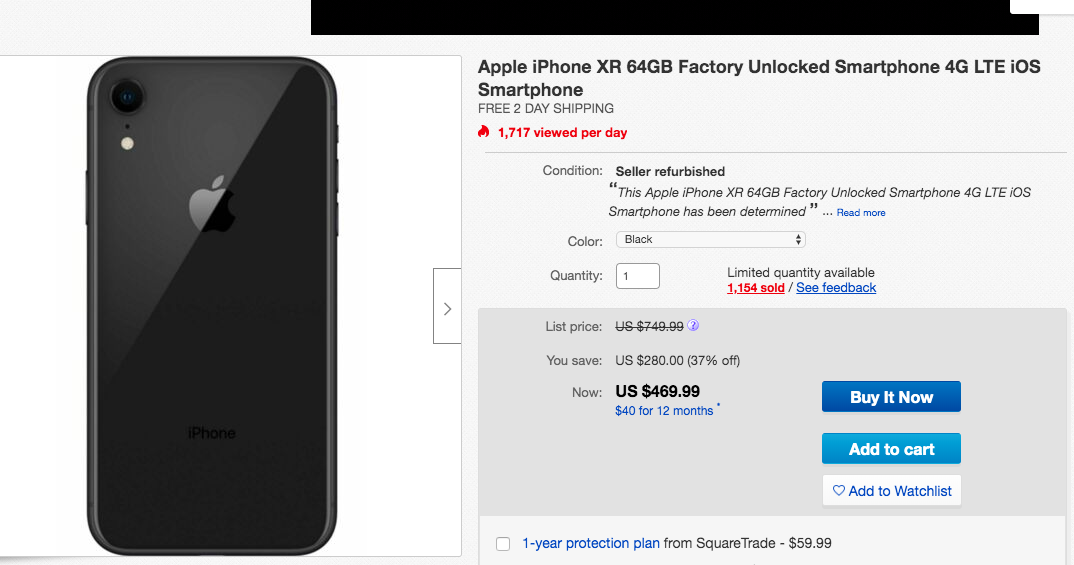8 eBay Selling Tips

8 eBay Tips for Selling Successfully
So, you want to sell on eBay. You’re not alone. As of 2019, eBay had over 183 million active buyers worldwide.[1] There are so many opportunities waiting for business owners on eBay, but there is also some steep competition—which is why it’s worth picking up a few eBay selling tips to help you find success on this massively popular online marketplace.
Becoming a top seller on eBay takes a lot of work and savvy, so keep reading for the best eBay tips for selling successfully.
8 Tips for Selling Items on eBay
Whether you’re just starting an eBay business or want to better optimize the one you have, there are a lot of ways you can make your business and products stand out with eBay listing tips and tricks. A mix of hard work, luck, and knowing how to play the eBay game will help you boost your sales. Consider some of these selling on eBay tips for beginners. Even sellers with years of experience can benefit from them.
Tip 1: Choose a Subscription Model
First things first. If you haven’t already chosen an eBay subscription model, that’s where you should start. Choosing the right subscription model can help you avoid fees and better optimize your eBay store. Depending on how much you’re planning to sell, you can choose the most cost-effective plan for your business. There may be eBay features that you don’t need and therefore don’t want to pay for. This will be especially helpful if you are a new business owner. There are five types of eBay subscription models for you to consider (note that the costs associated are monthly fees for an annual subscription).
| Subscription | Who It’s For | Monthly Fees |
|---|---|---|
|
Starter
|
For the occasional sellers
|
$4.95
|
|
Basic
|
For growing businesses
|
$21.95
|
|
Premium
|
For larger businesses
|
$59.95
|
|
Anchor
|
For volume sellers
|
$299.95
|
|
Enterprise
|
For large retailers
|
$2,999.95
|
Perks of an eBay subscription plan include a set number of free listings (up to 100,000 per month for Enterprise level), fixed-price listing fees if you exceed your monthly free listing allowance, shipping coupons, a customizable storefront homepage and web address, tools to help drive traffic, and in the case of Anchor and Enterprise levels, dedicated customer support.
Of course, you can also choose to not utilize a seller plan, which may be the right decision for businesses that don’t have very many items to list. You can take advantage of the free 50 listings every month and will only pay $0.35 for each listing after that. Although, more fees will apply once an item is sold.[2]
Tip 2: Optimize for SEO
If you don’t work in the marketing world, the term SEO might not mean much to you. SEO stands for “search engine optimization” and it helps web pages rank higher in search engines. Marketers utilize SEO tactics to make sure their web pages show up on the first few pages of search engines like Google. The closer to the top of the first page, the more likely your potential customers are to click into your site.
What many people don’t know is that eBay is a search engine. Which means you can SEO-optimize your listings to make sure that your listings show up right away when people search for the types of items you sell. Not sure where to start with SEO? Think about SEO like you’re staring on an episode of Jeopardy. Your listing is the answer, now you just have to provide the question.
For example. If you sell vintage vases, you’ll want to think about what types of search queries consumers are using on eBay. Likely, they are typing in specifics such as “1950’s vase” or “blue floral vase.” Whatever terms you think best match your products are what you should list them as. Not only should you apply this strategy to your product names, but also to the descriptions of each item.
And don’t be brief when it comes to descriptions; include as much information as possible so potential buyers know exactly what you’re selling. Include what year the product was made, brand names, materials, colors, etc. If your listings don’t see success, go back to the names and descriptions and see how you can better optimize them. It’s helpful to put yourself in the buyers’ shoes and think about what keywords and terms will help them find your products faster.
You should also apply SEO tactics to your store description. You want to make sure your store is easy to find and attracts the right audience.
Tip 3: Take Good Photos
You’ve got the text down, now it’s time to master your photography skills. While clear and thoughtful descriptions will help your products come up in search, no one will click if you have blurry, low-quality photos.
Not only will high-quality photos help make your products more sellable, but they can lessen returns and complaints because your customer will more clearly see what they’re buying. The last thing you want is to have a customer complain because they feel like your photos hid damage on a used item or misrepresented what they bought.
While you may not be a professional photographer, or be able to hire one, you can make your photos look professional by following a few key rules. Start with good lighting, a clear background, and use a decent quality camera or smartphone to take the photos. Make sure you take a variety of photos from different angles. You may also want to take photos that offer size comparisons. You can put your product next to a ruler or a common household item so that customers know exactly what to expect. (Of course, measurements should also be included in the description.)
Tip 4: Review Purchase Histories
Need a little help in the inspiration department? If you’re unsure of what the best direction to go with photography, text, title, or price, take a look at the purchase histories of similar items. The last thing you want to do is mislabel an item or price it too high. If you do, you risk being stuck with inventory that won’t sell.
Do a quick search of similar product listings on eBay. Once you’ve found an ideal match, go to the product page and find the information about how many products have been sold already (this information is in red text). When you find the sold products you can review the purchase history page of the product. From there you will be able to see when these products were purchased, for what price they sold, and what colors or other type they sold in. This information can help you a lot when it comes to finding the perfect selling price.
Step 1: Locate the red text that lists the number of items sold.

Step 2: Click the text to view the purchase history of the item to see quantity and styles sold, as well as price.

Tip 5: Stay Active and Time It Right
Timing is everything, in life and when selling on eBay. Because listings are only available for a set amount of time, choosing the right duration to list them is important. You don’t want to keep relisting your items, because that will continuously use up your free monthly listings.
When you list a new item, your start day is when your item is likely to appear at the top of the page, as it was listed recently. Take time to study when your target audience is on the platform and what times you’ve made sales in the past. Try to time your listings with these top selling times. If you aren’t sure what the best time for you to list is yet, in general, Sunday evening is a popular time on eBay.
eBay also rewards active users. If you keep your seller account active, you are more likely to show up higher in search results. If possible, list available items daily. For example, if you have seven items to sell, list one each day for a week. That will benefit you more than listing all of the items at once. You can also stay active in other ways, including interacting with your customers (more on that below).
Tip 6: Read the Seasonal Playbook
Speaking of timing, you might want to take a look at the bigger picture. eBay provides a “Seasonal Playbook” for sellers to help them find new ideas for profitable items to list. This guide highlights the peak season for certain items, alongside what typically sells on specific dates. The guide also shares key shipping dates (so you can prep for the holiday season) and offers listing title ideas. It’s a good resource to check in with a few times a year.
Tip 7: Provide Good Customer Service
As with any business, it’s important you provide good customer service. You want to make sure your customers’ concerns are resolved before purchasing. And you want to make them feel respected after the purchase.
A few good rules of customer service for eBay include replying to customer inquiries quickly (whether they have made a purchase or not), asking for feedback (so you can improve your business), and communicating with the customer about when and how their purchase will arrive. It’s also important to respond to any negative reviews quickly and work to resolve the issue so you don’t have unhappy customers. Hopefully, your top-notch customer service will help you avoid returns, but more on that in a second.
Tip 8: Minimize Returns
Transparency is the best policy if you want to minimize the amount of returns you get. By posting honest and accurate photos and product descriptions, you should be able to decrease the number of returns you receive. Promptly responding to any inquiries from potential customers will help too. You may be tempted to gloss over flaws of products listed (especially for used products), but that could get you into trouble later. It’s better to be upfront about the quality of your listings. Other ways to lessen your odds of returns are by packing items carefully so they don’t break in transit, sharing accurate measurements, selling fully functioning items, and providing authentication for designer items.
It will be impossible to avoid all returns, so don’t forget to clearly list your return policy. And no, you can’t skip this step. eBay requires their sellers to create a return policy and clearly communicate it with their customers. There are a variety of return options. You can even opt to do no returns (which still has to be communicated to customers), but in order to become a top-rated seller, you must offer your customers at least a 30-day return policy. If you want an extra visibility boost, eBay will reward you for offering free returns, by ranking your listing higher in eBay search.
eBay Selling Tips: The Bottom Line
Making a splash on eBay won’t be easy, but the potential rewards are worth all the hard work. If you play the game right by optimizing your listings, providing good customer service, and pricing your items right, you’ll find success. Hopefully some of these eBay listing tips and tricks gave you a jumping off point for boosting your eBay sales.
Article Sources:
- eBayInc.com. “Fast Facts“
- eBay.com. “Fees and Features“

Jacqueline DeMarco
Jacqueline DeMarco is a writer and editor based in Southern California. She has written on everything from finance to travel for publications including LendingTree, The Everygirl, Coveteur, and Apartment Therapy, among others. In her spare time, she enjoys traveling, especially if going somewhere she can spend time with animals.